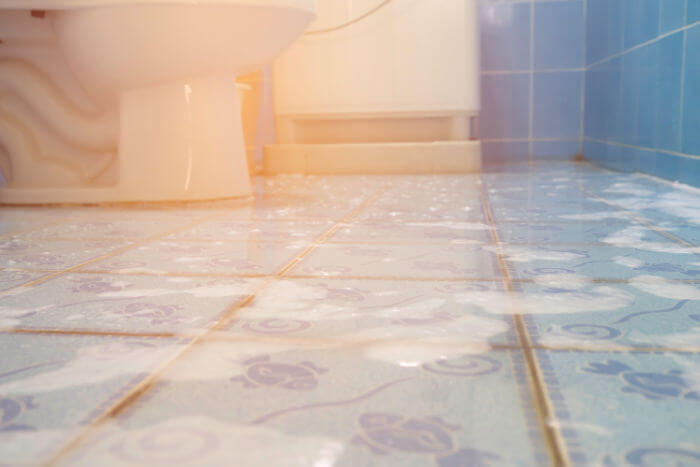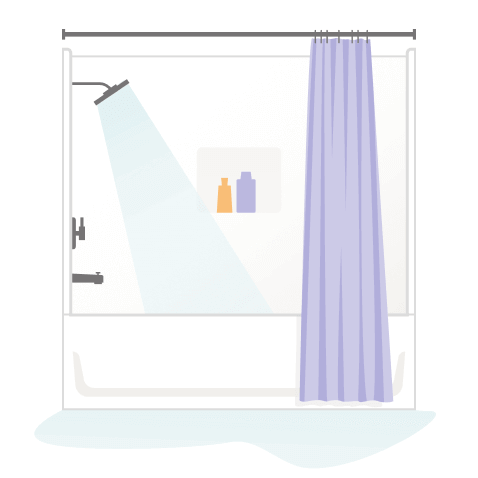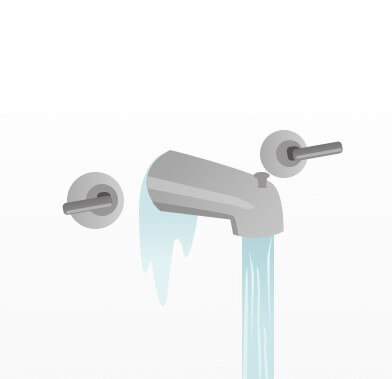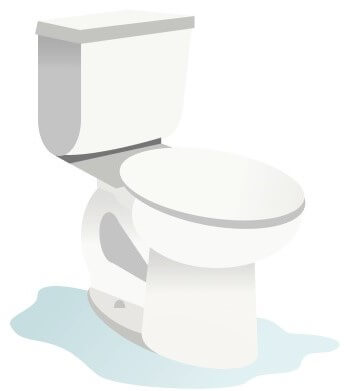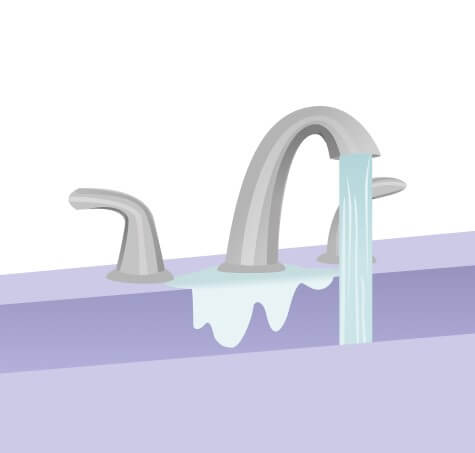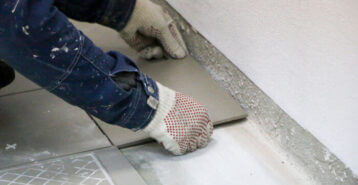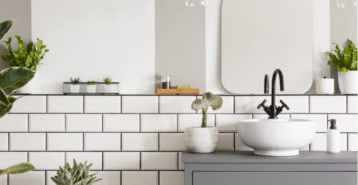Are you doing a bathroom remodel project?
Modernize can pair you with three to four pros in your area, so you can compare options and save time and money.
Finding a leak in your bathroom is a common, yet frustrating part of homeownership. Leaks in the sink, toilet, shower, or tub can easily cause stress and provoke an emergency response in a homeowner. Luckily, many of the common leaks you may detect in your bathroom are simple and affordable to fix if addressed promptly. This page will run through some of the most common bathroom leaks and plumbing issues, why they happen, and how to fix them before they lead to larger, more costly plumbing problems.
1. Splash Leaks
One of the most common bathroom leaks is a splash leak. As the name implies, this type of leak occurs when water escapes the tub or shower and splashes onto the floor. Although this type of leak is common and often easier to address than other leaks, splash leaks can cause serious damage to your home’s flooring—from curled vinyl floor planks and loose tiling to subfloor rotting.
Splash leaks are caused by using a bad or ineffective shower curtain, or old and worn caulking where the shower or tub meets the floor. But even bathrooms with shower doors can be impacted if the gasket is damaged or the frame is dislodged.
These leaks can be spotted by inspecting for water pools around the outside of the tub or shower after use. Keep in mind that water might take several minutes to appear. You might also notice damage or molding on the surrounding floors.
Depending on the exact cause of the leak, a splash leak can be fixed by replacing your shower curtain, re-caulking around the tub or shower door, replacing the shower door gaskets, or having a new frame installed.
In serious cases, you may need to have your shower or bathtub replaced.
Consult with a bathroom professional if you can’t find the cause of the splash leak.
2. Bathtub Faucet Leaks
A bathtub faucet leak happens to most homeowners every few years. But if left unrepaired, the leak can result in higher a water bill and eventually damage to other faucet components – or even the surrounding wall.
Typically, a bathroom faucet leak is caused by a worn or damaged washer in the faucet stem. As the faucet is repeatedly turned on over time, the valve friction wears down the washer, allowing water to seep through.
Occasionally, the leak might be caused by damage to the faucet or stem itself, or piping to the faucet.
If a damaged washer is the source of the issue, repairs can be done by removing the faucet handle, removing and inspecting the faucet stem, and replacing the washer or any other stem component that is showing signs of damage.
You may need a bathtub faucet replacement if the leak is more severe.
3. Toilet Leaking From the Base
Few things can be as concerning to a homeowner as a toilet leaking from the base. Fortunately, if spotted early enough, these leaks can be addressed without much headache.
If you notice your toilet is leaking from the base, first make sure the excess water is actually coming from the base. Sometimes, pooled water around the toilet can also be caused by:
Find the Right Contractor for Your Bathroom Remodeling Project
Whether you’re ready to begin your project now or need some expert advice, our network of contractors are here to help. With a few simple questions, we’ll find the best local professionals for you
- a loose connection tube between the toilet and the tank
- a faulty shut-off valve
- a cracked bowl
A toilet base leak can occasionally be fixed by simply tightening the bolts that connect the toilet to the floor. But do not tighten too much, or you can crack the base.
If that does not solve the problem, you will have to remove the toilet and replace the wax gasket that connects the toilet to the flooring below.
Inspecting and replacing the base level components of your toilet is best left to a professional to ensure the issue is resolved and no further damage is done to the bathroom. Ignoring this problem can lead to water damage in other areas of your home – especially if the toilet is in an upper floor bathroom. If the leak worsens, it may be time to replace the toilet.
4. Leaks From the Sink Faucet
Much like a leaky bathtub faucet, most homeowners will eventually have a bathroom sink faucet leak. And also like its bathtub counterpart, a leaky sink is typically caused by a damaged washer, gasket, o-ring, or stem. These components are worn down over time by the continued use of the valve to turn the water on and off—leading to water leaking through.
A bathroom sink faucet link can be addressed by doing the following:
- Shut off the water supply. For most sinks, this can be found in the housing beneath it. If no supply valve is present, turn off the home’s water supply.
- Remove the faucet handle, which will vary based on the type of handle your sink has installed.
- Once the handle is removed, you will be able to access the stem or cartridge. Gently remove this component and inspect for damage.
- Replace any worn out parts or swap out for a new stem.
- Put the faucet handle back in place.
- Turn the water supply back on.
Typically, the entire stem can be easily and affordably replaced, but some homeowners might opt to only replace certain parts, such as swapping in a new o-ring.
If the sink is very old, worn, and damaged, it may be time to replace the entire bathroom sink.
5. Clogged Sinks
A clogged bathroom sink is a major annoyance for almost every homeowner. Luckily, there are several remedies for the issue.
A sink can become clogged for an assortment of reasons. Primarily, the buildup of hair, soap scum, or other small debris that finds its way into your sink’s drain.
Typically, a clogged sink can be fixed with a little DIY skill:
- Plunge. Sometimes a simple plunger is all you need to unclog a sink. Just give it a few plunges with a few inches of pooled water.
- Pour boiling water. Carefully and slowly pouring boiling water down the drain can help break up some clogs. Do not use this method if your sink is made from porcelain.
- Use baking soda and vinegar. Add a few tablespoons of baking soda to the drain, followed by several ounces of white vinegar. Allow the reaction caused by the mixture to sit for 10 to 15 minutes and flush with boiling water (skip this last step if you have a porcelain sink).
- Add a store-bought cleaner if needed. You’ll find these at most hardware or grocery stores. Simply follow the directions on the bottle to clear the clog.
- Drain snake. You can find drain snakes at most any hardware store. While some look more complex than others, they all function essentially the same. Feed the cable through your drain until the clog is reached, then clear it. Do not forget to cover the drain with a rag while doing this, or you might end up with a mess.
Next Steps For Fixing Bathroom Leaks
The key with any bathroom leak is to address it as promptly as possible. Ignoring a leak in the bathroom often leads to more intense and costly plumbing issues – ranging from mold to severe water damage.
If nothing is done to solve the leak, it can start to wreak havoc on your sink, toilet, tub, shower, or floor. Then, you’ll be looking at total replacement projects instead of repairs. It is almost always easier and more affordable to fix a leak when you nip the problem in the bud.
If any of the problems addressed in this article persist or require more laborious work, contact the experts at Modernize by clicking below to connect you with a trusted professional in your area.
Find the Right Contractor for Your Bathroom Remodeling Project
Whether you’re ready to begin your project now or need some expert advice, our network of contractors are here to help. With a few simple questions, we’ll find the best local professionals for you
Reviews from Real Homeowners
Welcome to Homeowner Resources! We are the Modernize blog. Modernize pairs more than 3 million homeowners a year with pre-vetted contractors in their area. This blog started because we believe homeowners should know everything about their homes, from how their HVAC works to which front door colors they might love. On Homeowner Resources, you can find information on every part of your home, right down to how you can negotiate with contractors to get the best price. Here's more about the blog.
Need a contractor? Learn more about how Modernize finds the right pro for you.
